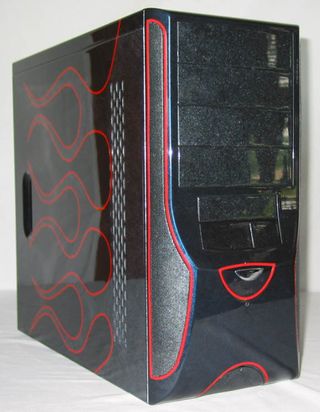How To Customize Your PC Case & Achieve Professional Results
THG's Exclusive Interview With Steve Horch, Continued
THG - When you paint more than just the computer case, don't you have deal with a lot of voided warranty issues when devices fail?
SH - Well, of course, the warranty coverage is up to the company that sells the product. In most cases, painting the product will void the warranty. This is why, prior to choosing to paint your optical drives, as an example, it is important that you understand that if your DVD-ROM drive fails, the manufacturer may not replace it under warranty because it has been painted. Companies that offer computer painting and computer product painting, on the other hand, usually offer a warranty for the parts that they paint.
In the case of Crazypaint, I offer a warranty on all of the products that I paint. For example, if I paint a DVD-ROM drive and the warranty on the drive is one year, I will have spare products in stock for replacement for one year from your date of purchase of the product painting. For warranty coverage, the customer simply would ship me the defective product. I would then pull the faceplate off the painted (defective) drive, unpack a new replacement drive, reinstall the painted faceplate onto the replacement drive, and ship it back to the customer. As a result, I have the defective drive that once again has a beige faceplate, and I can return this plain drive for replacement. This is why I recommend that if you are going to paint your optical drives, first locate a drive that has a faceplate that can be easily removed without voiding the warranty.
Since painted optical drives are important to the overall look in matching the color scheme of your system, you might want to consider purchasing a spare drive of the same type in case you are worried about warranty and replacement. However, it is my opinion that if you use a resource such as Tom's Hardware Guide and choose quality components, failures are not normally an issue. Painting the floppy drive and optical drives really does add to the custom look of the case. Personally speaking, I consider this to be one of the factors that allows you to tell the well-painted cases from the poorly painted ones.

After seeing this Super Case in a local shop, I wanted to see what could be done with an even lower cost case. The Super Case turned out to be a pretty easy case to work with and the marbleizer, as well as the pin striping, showed this case well and gave it the 'pop' that I was looking for. Due to the fact that I used a lower cost case, I was able to shave a few additional dollars off the selling price of this case. The size of this case is still a little cramped compared to other cases that I normally paint.
THG - Why do you think that so many cases use optical drives and floppy drives that are not painted?
SH - That is a good question! I feel that in order to achieve the ultimate look for a case, the drives need to be painted. I look at some designs and am curious as to why they didn't paint the drive faceplates. Leaving the faceplates unpainted really gives your overall design a very unfinished look, and makes people think you stopped short of finishing it. Painting the faceplates of both your optical drives and floppy drives isn't hard to do, if you choose drives with removable faceplates. You also have to wonder if some companies don't believe in the drive brands that they use in their systems because they are afraid of or don't want to deal with the possible warranty issues. The key is to take your time and remove the faceplates slowly, and make sure that you don't break the locking tabs in the process. Some companies will sell you replacement faceplates for your drives, for a price. Of course, this varies from company to company, but it is worth considering.
Stay on the Cutting Edge
Join the experts who read Tom's Hardware for the inside track on enthusiast PC tech news — and have for over 25 years. We'll send breaking news and in-depth reviews of CPUs, GPUs, AI, maker hardware and more straight to your inbox.
Again, don't try to mask off the drive and paint the faceplate while it is still on the drive. This is a common mistake that people make, and the paint over spray can destroy your drive. Once again, you need to pay attention to proper prep work and prime everything before painting it. There continues to be the common misconception that you don't have to prime plastic. In fact, paint will stick to plastic, but these drives get hot, and excessive heat will cause polymers to be released from the plastic. Primer paint creates a barrier between the paint and these polymers to allow for proper adhesion. This is no different from when you are painting the front of your cases, which, in most cases, are also made out of plastic. When we talk about heat, I am not necessarily talking about the drives themselves, but the heat that is generated within the case that bleeds through and around these devices which can cause adhesion issues without proper prep work. While it might be easier to use regular or off-the-shelf drives, I think we have pointed out that it is something that you don't want to do if you want the most professional look possible.
Current page: THG's Exclusive Interview With Steve Horch, Continued
Prev Page THG's Exclusive Interview With Steve Horch, Continued Next Page THG's Exclusive Interview With Steve Horch, ContinuedMost Popular

